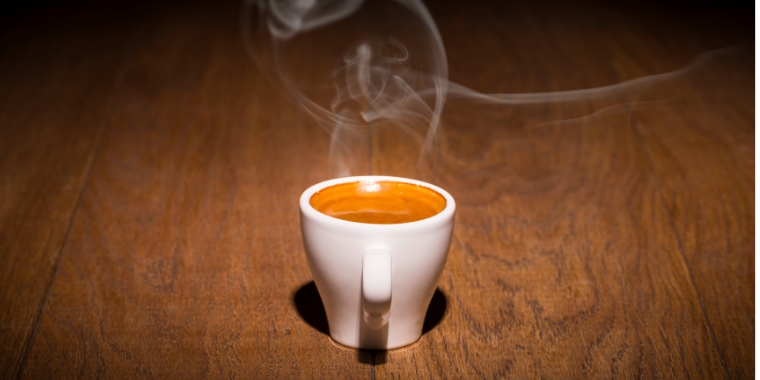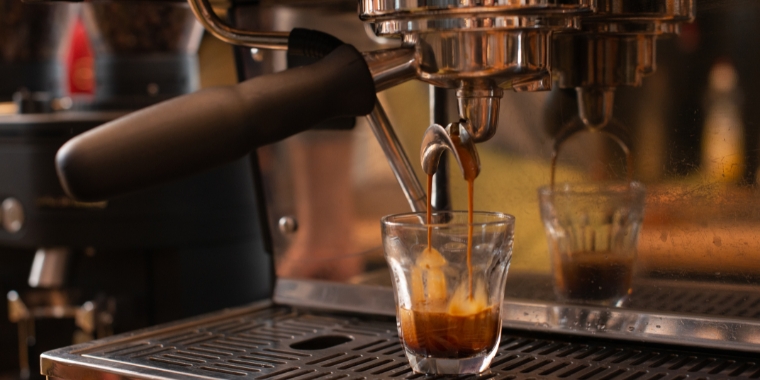Do you want to know how does espresso taste like?
Well, it’s a bit like trying to describe the color of a chameleon – it depends on the blend, roast level, and brewing method.
But don’t worry, I’ll help you navigate this caffeine-fueled labyrinth and discover the rich and complex world of espresso.
Whether you’re a seasoned coffee connoisseur or a curious newbie, buckle up and get ready to taste the magic.
- What Does Espresso Taste Like?
- Does Espresso Taste Like Coffee?
- What Are The Primary Flavor Notes In Espresso?
- What Are Some Common Flavor Defects Found In Poorly Made Espresso Shots?
- How Does The Roast Level Affect The Taste of Espresso?
- How Is Espresso Supposed To Taste – Questions You’ve Asked
- How To Properly Taste Espresso
- My Final Thoughts
What Does Espresso Taste Like?

You know what they say, good things come in small packages – and this little shot of caffeine packs a serious punch.
This little shot of caffeine magic is a flavor powerhouse, with a taste, aroma, and mouthfeel that’ll make your head spin. Trust me, I’m practically an espresso ambassador at this point.
So what makes espresso so special? Well, it’s all in the details.
The high coffee-to-water ratio and short brewing time result in a flavor that’s intense and complex, with a bold balance of bitterness and sweetness. Think of it like a yin-yang situation, but for your taste buds.
The bitterness comes from those roasted coffee beans, which are a defining characteristic of espresso. The sweetness on the other hand comes from the natural sugars in the beans, so you get a little bit of sweetness to balance out the bitterness.
Espresso is also known for its thick and creamy body, thanks to the emulsification of oils during the brewing process. It creates a velvety mouthfeel that coats your tongue and lingers long after the last sip.
For those in a hurry, here’s a brief summary:
Espresso is a unique coffee that is prized for its strong, intense, and complex flavor profile, which can range from bitter and earthy to sweet and fruity.
Does Espresso Taste Like Coffee?

Yes, espresso is a type of coffee, so it does taste like coffee.
Espresso is brewed using a high-pressure extraction method that extracts the flavors and oils from finely ground coffee beans faster than it takes for me to put on a pair of pants in the morning. This process creates a concentrated and robust coffee flavor that’s way stronger than a drip coffee.
But that’s not all! Espresso’s got something else going on, too – that thick and velvety texture that makes you want to cozy up and stay a while.
It’s like a warm blanket for your mouth, and let me tell you, once you’ve had a taste, you’ll never want to go back to those wimpy drip coffees again.
For those in a hurry, here’s a brief summary:
While espresso does taste like coffee, its unique flavor profile and brewing method make it stand out from other coffee types.
What Are The Primary Flavor Notes In Espresso?

Espresso is known for its rich and complex flavor profile, which includes a wide range of primary and secondary flavor notes. Some of the espresso’s most common flavor notes include chocolate, caramel, and nutty flavors.
Chocolate notes
Chocolate notes in espresso can take you on a flavor journey from a lazy river of light milk chocolate to a thrilling rollercoaster ride of darker and more intense cocoa flavor. And just when you think the ride is over, bam! Caramel or vanilla jumps out from behind a flavor corner to add sweetness and depth to the whole shebang.
Caramel notes
Caramel notes in espresso are created by the caramelization of sugars during the roasting process. This creates a sweet and rich flavor profile that is often described as buttery but personally, I just call them “toffee-like”.
Nutty notes
Espresso can give you a nutty experience, ranging from a light almond or hazelnut flavor to a more robust and earthy taste. These nutty flavors come from the roasting process, and the type of coffee beans used and the roast level can also nut things up [you can learn more about it from here].
Fruity or floral notes
Other secondary flavor notes in espresso can include fruity or floral notes, which are often created by the type of coffee beans used and the brewing method. These notes can add a bright and refreshing flavor profile to espresso, balancing out the bitterness and richness of the coffee.
For those in a hurry, here’s a brief summary:
Espresso has a rich and complex flavor profile with primary and secondary flavor notes that include chocolate, caramel, and nutty flavors, and can also have fruity or floral notes which add a bright and refreshing taste to balance out the bitterness and richness of the coffee.
What Are Some Common Flavor Defects Found In Poorly Made Espresso Shots?

Let’s talk about the flavor defects that can turn a perfectly good espresso shot into a mouthful of disappointment. Here are some of the most common culprits:
1: Sourness
If your espresso shot tastes like you just licked a lemon, it’s probably because the water didn’t hang out with the coffee long enough. What does it mean? under-extraction! The result? A sharp, unpleasant taste that’ll make you pucker.
2: Bitterness
On the other end of the spectrum, over-extracted espresso can taste like burnt rubber. Not exactly what you want to start your day with.
3: Weakness
Did you order a shot of espresso or a glass of water? If your espresso shot is weak, it’s probably because the barista didn’t use enough coffee. The result? A sad, watery shot that won’t wake you up.
4: Astringency
If your espresso shot leaves you feeling like you’ve been sucking on a teabag, it’s probably because the coffee beans are old or the water is too hot.
5: Metallic or chemical taste
If your espresso shot tastes like you’re drinking from a rusty pipe, it’s time for the barista to clean their equipment. Or maybe they’re just brewing with water from the Flint River.
Remember, there are a ton of factors that go into making a good espresso shot, so don’t blame the barista too hard. Just make sure to tip extra for the ones that get it right!
For those in a hurry, here’s a brief summary:
Poorly made espresso shots can have several flavor defects including sourness, bitterness, weakness, strength, astringency, or a metallic/chemical taste, caused by various factors.
The most common ones are under-extraction, over-extraction, and using old coffee beans.
How Does The Roast Level Affect The Taste of Espresso?

The roast level of coffee beans can have a significant impact on the taste of espresso.
Roast level refers to the degree to which the coffee beans are roasted, which can range from light to dark roast. Each roast level produces a unique flavor profile that can impact the taste of espresso in different ways.
Light roast coffee beans
Roasted for a shorter period of time and at a lower temperature than dark roast coffee beans. This results in a lighter color and a milder flavor profile, with a brighter and more acidic taste.
Light roast coffee beans can also have more complex and nuanced flavor notes, such as floral or fruity notes, that can add a pleasant and refreshing taste to the espresso shot.
Medium roast coffee beans
Roasted for a slightly longer period of time than light roast coffee beans. This results in a medium-brown color and a more balanced flavor profile, with a mix of acidity and sweetness.
Medium roast coffee beans can also have nutty or chocolatey flavor notes, which can add depth and richness to the taste of espresso.
Dark roast coffee beans
Roasted for the longest period of time and at the highest temperature. This results in a dark brown or black color and a bold and intense flavor profile, with a strong and smoky taste.
Dark roast coffee beans can also have a range of flavor notes, including chocolate, caramel, or nutty notes, that can contribute to the overall taste of espresso.
For those in a hurry, here’s a brief summary:
The roast level of coffee beans can impact the taste of espresso in several ways. Light roast coffee beans can produce a brighter and more complex flavor profile, while medium roast coffee beans can produce a more balanced and nuanced taste. Dark roast coffee beans can produce a bold and intense flavor profile.
How Is Espresso Supposed To Taste – Questions You’ve Asked

Is Espresso Bitter or Sweet?
Espresso can have both bitter and sweet notes at the same time.
Bitterness is a defining characteristic of espresso and comes from roasted coffee beans. This bitterness is balanced by the natural sweetness of the coffee, which is created by the caramelization of sugars during the roasting process.
The sweetness in espresso can manifest as a range of flavors, from light floral sweetness to a rich and chocolaty sweetness. The sweetness can also be influenced by the type of coffee beans used and the brewing method. Some espresso shots may have a more pronounced bitter taste, while others may have a more prominent sweet taste.
Is Espresso Strong?
Espresso is often described as strong, but this can be a bit misleading.
When people say that espresso is strong, they are usually referring to its bold and intense flavor profile, rather than its caffeine content.
In fact, a single shot of espresso contains less caffeine than a standard cup of coffee, but the flavor is much more concentrated.
How To Properly Taste Espresso
Properly tasting espresso requires attention to detail and an understanding of the key flavor, aroma, and mouthfeel components.
To taste espresso properly, start by observing the appearance of the shot, noting the thickness and consistency of the crema and the color of the shot.
Next, smell the aroma of the shot and take note of the strength and complexity of the aroma.
When tasting the espresso, take a small sip and note the primary flavor notes of bitterness, sweetness, and acidity, as well as any secondary flavor notes such as chocolate or nutty flavors.
Evaluate the mouthfeel of the shot, noting the thickness, creaminess, and texture.
By properly tasting espresso and comparing different shots side-by-side, you can gain a deeper understanding of the nuances of espresso and identify the flavor profiles that you enjoy the most.
Read next: What is Espresso Coffee Crema?
My Final Thoughts
Espresso is like that quirky friend you just can’t get enough of – bold, complex, and full of surprises!
So, how is espresso supposed to taste? It should have a little bit of everything, from bitterness to sweetness to acidity.
And that thick and creamy texture? It’s like the cherry on top of a sundae – the perfect finishing touch.
Brewed and extracted just right, espresso is like a warm hug from your bestie.
So grab a cup, take a sip, and appreciate the magical mystery that is espresso!


